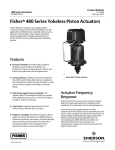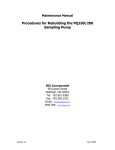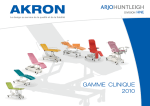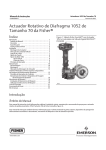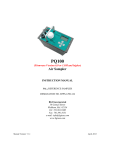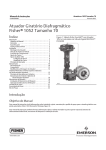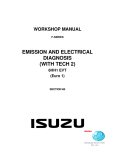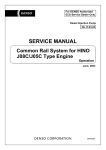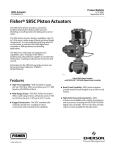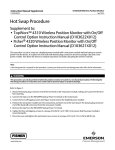Download Emerson Fisher 480 Installation Instructions
Transcript
Instruction Manual 480 Series Actuators D100291X012 August 2012 Fisherr 480 Series Yokeless Piston Actuators Contents Figure 1. Fisher 480-15 Piston Actuator Introduction . . . . . . . . . . . . . . . . . . . . . . . . . . . . . . . . . 1 Scope of Manual . . . . . . . . . . . . . . . . . . . . . . . . . . . . . 1 Description . . . . . . . . . . . . . . . . . . . . . . . . . . . . . . . . . 1 Specifications . . . . . . . . . . . . . . . . . . . . . . . . . . . . . . . 1 Actuator Configurations . . . . . . . . . . . . . . . . . . . . . . . 4 Installation . . . . . . . . . . . . . . . . . . . . . . . . . . . . . . . . . . 5 Principle of Operation . . . . . . . . . . . . . . . . . . . . . . . . . 6 Pressure Connections . . . . . . . . . . . . . . . . . . . . . . . . . 7 Adjustments . . . . . . . . . . . . . . . . . . . . . . . . . . . . . . . . . 7 Actuator Maintenance . . . . . . . . . . . . . . . . . . . . . . . . . 8 Disassembly . . . . . . . . . . . . . . . . . . . . . . . . . . . . . . . . 8 Parts Ordering . . . . . . . . . . . . . . . . . . . . . . . . . . . . . . . 12 Parts List . . . . . . . . . . . . . . . . . . . . . . . . . . . . . . . . . . . 12 W1867 Introduction Scope of Manual This instruction manual provides installation, maintenance, and parts information for Fisher 480 Series yokeless piston actuators. Do not install, operate, or maintain 480 Series actuators without being fully trained and qualified in valve, actuator, and accessory installation, operation, and maintenance. To avoid personal injury or property damage, it is important to carefully read, understand, and follow all the contents of this manual, including all safety cautions and warnings. If you have any questions about these instructions, contact your Emerson Process Management sales office before proceeding. Description 480 Series actuators (figure 1) are yokeless piston actuators that are used in either throttling or on-off applications with ball valves, butterfly valves, louvers, dampers, and rheostats. They require pneumatic pressure loading from double-acting positioners (Fisher 3570) or from on-off loading and unloading devices. Specifications Table 1 lists specifications for the 480 Series actuator and table 3 lists specifications for the 3570 actuator. www.Fisher.com Instruction Manual 480 Series Actuators August 2012 D100291X012 Table 1. Fisher 480 Series Actuator Specifications Stroking Speeds Available Configurations See table 2 See the Actuator Configurations section. Operative Ambient Temperature(2) Cylinder Pressure With Nitrile O-Rings: -46 to 80_C (-50 to 175_F) With Fluorocarbon O-Rings (Optional):(3) -18 to 149_C (0 to 300_F) Maximum Allowable:(4) 10.3 bar (150 psig) Required to Produce a Given Thrust: See figure 2 Minimum Recommended: Valves with low torque requirements -- (2.4 bar [35 psig]); all other valves -(3.4 bar [50 psig]) Actuator Size and Piston Size See table 2 Maximum Supply Source Consumption Pressure Connections With Positioner and Constant Input Signal: 0.54 normal m3/hr(1) (20 scfh(1)) of air at 6.9 bar (100 psig) Without Positioner: Depends on cylinder volume and supply pressure Standard is 1/4 NPT. For larger sizes, contact your Emerson Process Management sales office. Construction Materials Actuator: Travel Information Maximum Rated Travels, All 480 Series actuators with Linear Output: See table 2 Travel Stops Available for 480 Series actuators with 105 mm (4.125 inch ) Maximum Rated Travels: See table 2 Part Material Cylinder and Piston Aluminum Piston Rod Extension SST, Chrome Plated Cylinder Seal Bushings Brass O-Rings Nitrile or Fluorocarbon Thrust Information See figure 2 Options J 376 Series trip valve system to fail actuator J up or J down or J lock in last position J TopWorxt DXP M21GNEB electrical valve stem position switch J Micro-Switch limit switches Torque Output 480, 480-15, and 480-16 (for butterfly valves): Contact your Emerson Process Management sales office 1. Normal m3/hr.- normal cubic meters per hour (0_C and 1.01325 bar, absolute); Scfh - standard cubic feet per hour (60_F and 14.7 psia). 2. These terms are defined in ANSI/ISA Standard S51.1 3. Without snubber. If this actuator has a snubber, the temperature specification is the same for the nitrile version. 4. The pressure limits in this bulletin and any applicable standard or code limitation for actuator should not be exceeded. Table 2. Size, Piston, Stroking Speed, and Travel Information ACTUATOR SIZE EFFECTIVE PISTON AREA Cm2 PISTON DIAMETER Inch2 mm STROKING SPEED(1) Inch mm/ s SINGLE-FLANGE –16 Versions All Others Except Fisher 487, 487-1(2) TRAVEL STOPS AVAILABLE FOR ACTUATORS WITH 105 mm (4.125 INCHES) MAXIMUM RATED TRAVEL Inch/s mm Inch mm Inch mm Inch 30 107 16.5 121 4.75 102 4 --- --- 105 4.125 89 3.5 40 60 182 258 28.25 55.5 156 216 6.125 8.5 52 33 2.05 1.30 206 8.125 105 4.125 89 3.5 1. For actuators with positioners at 6.9 bar (100 psig) supply pressure and all prestroke conditions satisfied. Stroking speeds for actuators without positioners or with snubbers will depend on the particular construction involved. 2. See 480 series Actuators Specifications for these travels. 2 Instruction Manual 480 Series Actuators D100291X012 August 2012 Table 3. Fisher 3570 Actuator Specifications Available Configurations 3570: Valve positioner with two relays and three pressure gauges for monitoring input signal and output pressures to the top and underside of the actuator piston 3570C: Similar to 3570 except that the positioner is equipped with automotive tire valves instead of pressure gauges. The valves can be used for clip-on test pressures gauges. The relay nozzles on these positioners are locked in place with locknuts to resist unwanted nozzle movement due to vibration Input Signal Standard Ranges: 0.2 to 1.0 bar (3 to 15 psig) or 0.4 to 2.0 bar (6 to 30 psig) Split Ranges: Typically uses one half of standard range when two control valves are operated by one input signal from a single controller Optional Ranges: As required within the limits of the bellows Bellows Pressure Rating Standard Bellows: 3.4 bar (50 psig) Optional Bellows: 6.2 bar (90 psig) Supply Pressure Maximum: 10.3 bar (150 psig) Minimum: 2.4 bar (35 psig) Output Signal Type: Pneumatic pressure as required by the actuator Action: Field reversible between direct and reverse (see table 4) Hysteresis(1,2) 0.15% of total stroke or instrument pressure span Resolution(1,2) 0.2% of instrument pressure span Repeatability(1,2) 0.3% of instrument pressure span Frequency Response(1,2) See figure 3 Pressure Connections Vent: 3/8 NPT All Others: 1/4 NPT Pressure Indications 3570C: Tire valves accept standard pressure gauge chucks 3570: See table below Type of Indication Number Used Standard Gauge Range bar (psig) Positioner input signal gauge 1 0 to 2.1 (0 to 30) or 0 to 4.1 (0 to 60) Cylinder supply pressure gauge 0 0 to 11.0 (0 to 160) Static Air Consumption(3) 0.56 normal m3/hr (20 scfh) with 6.9 bar (100 psig) supply pressure Operative Ambient Temperature(1,2) With Nitrile O-Rings: -34 to 79_C (-30 to 175_F) With Fluorocarbon O-Rings (Optional):(3) -18 to 149_C (0 to 300_F) Construction Materials Actuator: Part Material Base, Cover and Beam Bellows Bias and Range Spring Relay Body Relay Nozzle(s) Diaphragm O-Rings Aluminum, die cast Brass Steel, Plated Zinc, Die Cast SST Nitrile or Fluorocarbon Nitrile or Fluorocarbon Options Fisher SS-52 clip-on chuck (with or without gauge) for 3570C positioners 1. These terms are defined in ANSI/ISA Standard S51.1 2. For actuator with positioner only. Does not apply to other constructions or actuator-valve combination. 3. Normal m3/hr.- normal cubic meters per hour (0_C and 1.01325 bar, absolute); Scfh - standard cubic feet per hour (60_F and 14.7 psia). 3 Instruction Manual 480 Series Actuators August 2012 D100291X012 Figure 2. Supply Pressure and Thrusts SIZE 30 ACTUATOR SIZE 40 ACTUATOR SIZE 60 ACTUATOR THRUSTS IN THOUSANDS OF POUNDS (IN THOUSANDS OF NEWTONS) FOR ACTUATORS WITH POSITIONERS NOTE: A5961 MAY BE INCREASED BY 10% FOR ACTUATORS WITHOUT POSITIONERS. EITHER THIS THRUST, OR THE MAXUMUM ALLOWABLE LOADING FOR THE CONTROL DEVICE IS THE LIMITING FACTOR FOR USABLE ACTUATOR FORCE. Figure 3. Frequency Response 1. SIZE 30– 19mm (0.75 INCH) TRAVEL 2. SIZE 40– 38mm (1.5 INCH) TRAVEL 3. SIZE 60– 38mm (1.5 INCH) TRAVEL A5962 Actuator Configurations 480: Yokeless piston actuator with positioner. 481: Yokeless piston actuator without positioner. Other actuators may be obtained without positioner by adding -1 to the type number. The above actuators come with standard mounting flange, 105 mm (4.125 inch) maximum rated travel, and threaded piston rod connection with sizes 30 through 60 for mounting on ball valves, louvers, and dampers with brackets. These actuators may be obtained with the following alternate universal mounting flange constructions: -15 Added to Type Number: Allows butterfly valve mounting for a standard actuator with 105 mm (4.125 inch) maximum travel and threaded piston rod connection, and comes in sizes 30 through 60. -16 Added to Type Number: Provides 206 mm (8.125 inch) maximum travel and threaded piston rod connection, and comes in sizes 40 through 60. 4 Instruction Manual 480 Series Actuators D100291X012 August 2012 Table 4. Action Under Normal Operating Conditions DESIRED PISTON MOTION ACTUATOR DESCRIPTION With Positioner Down Up Direct-acting Increasing input signal pressure to bellows(1) Decreasing input signal pressure to bellows(1) Reverse-acting Decreasing input signal pressure to bellows(1) Increasing input signal pressure to bellows(1) Supply pressure loaded on top of piston, exhausted from bottom Supply pressure loaded on bottom of piston, exhausted from top Without positioner 1. Supply pressure is routed through relays to piston. Installation WARNING Always wear protective gloves, clothing, and eyewear when performing any installation operations to avoid personal injury. Personal injury or equipment damage caused by sudden release of pressure may result if the valve assembly is installed where service conditions could exceed the limits given in table 1 or 3 or on the appropriate nameplates. To avoid such injury or damage, provide a relief valve for overpressure protection as required by accepted industry or local, state, and Federal codes and good engineering practices. Check with your process or safety engineer for any additional measures that must be taken to protect against process media. If installing into an existing application, also refer to the WARNING at the beginning of the Maintenance section in this instruction manual. Inspect this equipment on arrival to note any damage which may have occurred in transit. If the actuator is attached to a valve body when received, install the valve in the pipeline with flow in the direction of the arrow on the valve body. (Some valve types, notably various butterfly valves, can be installed with flow in either direction and are unmarked as to proper flow direction.) A three-valve bypass around the main valve is recommended to permit continuous operation during periodic maintenance or inspection of the main valve. Figure 4. Operation of Actuator with Positioner FIXED RESTRICTION RANGE SPRING BIAS SPRING BELLOWS REVERSED POSITION RELAY B INSTRUMENT BEAM SUPPLY SUPPLY BJ8256-A A1286 RELAY A FIXED RESTRICTION INSTRUMENT PRESSURE SUPPLY PRESSURE TOP CYLINDER PRESSURE BOTTOM CYLINDER PRESSURE NOZZLE PRESSURE 5 Instruction Manual 480 Series Actuators August 2012 D100291X012 When 480 Series actuators are supplied to operate dampers, louvers, or similar equipment, a suitable mounting plate should be provided, and the piston rod of the actuator connected to the operating arm of the damper, etc., with appropriate linkage. Figure 5. Cylinder Diameter and Bolt Center Location, All Actuators (refer to table 5) BH9452-K A1290 Table 5. Cylinder Diameter and Bolt Center Location, All Actuators ACTUATOR SIZE C H, DEGREE OF ARC mm Inch Standard Flange Universal Mounting Flange 30 171 6.75 0 45 40 206 8.12 45 45 60 267 10.50 22.5 45 Figure 6. Operation of Actuator with Snubber SNUBBER CHECK VALVES POSITIONER OR SWITCH -ING DEVICE SUPPLY PRESSURE TOP CYLINDER PRESSURE BOTTOM CYLINDER PRESSURE UPPER SNUBBER PRESSURE LOWER SNUBBER PRESSURE 32A8303-A A1287 Principle of Operation Actuator These actuators react to a pressure unbalance that is created by loading supply pressure on one side of the piston and unloading the opposite side. Some type of switching device is required to shift the supply pressure from one side of 6 Instruction Manual D100291X012 480 Series Actuators August 2012 the piston to the other. For most actuators in the 480 Series, this device is a 3570 positioner. However, a separate loading device must be provided for actuators without positioners. For actuators with positioners (figure 4), the pneumatic output signal from a controller or instrument is piped to the positioner bellows. As long as the bellows receives a constant input signal pressure, the beam remains motionless and allows supply pressure to bleed through both relay nozzles so that a constant pressure is maintained between the nozzle and the fixed orifice. The relays are in equilibrium with their inlet and exhaust valves closed. Assume that a downward piston motion is required and the bellows receives a corresponding change in input signal pressure. This causes the beam to pivot so that it covers the nozzle on relay A. (Beam movement is accomplished either by increasing the input signal pressure on a direct-acting positioner to expand the bellows, or by decreasing the input signal pressure on a reverse-acting positioner to contract the bellows.) The nozzle pressure in relay A increases due to the restriction created by the beam over the nozzle. Through relay action, the air pressure to the top of the piston is increased. At the same time, relay B reacts to the change in beam position to decrease the pressure to the underside of the piston. Due to the resulting unbalanced forces acting on the piston, it moves down, changing the valve plug position. Piston movement is fed back to the beam by means of a range spring which is connected to the beam and to the piston rod extension, applying a force to the beam opposite to that caused by the expanding or contracting bellows. This feedback arrangement prevents overcorrection and ensures a definite position of the piston and valve plug for a given instrument signal. If upward piston motion is required, the beam pivots over the nozzle on relay B. The result is relay, piston, and feedback action opposite that for downward piston motion. Reversal of positioner action is accomplished simply by removing four screws, inverting the bellows, and installing two bellows posts for support it the change is from direct to reverse action. Bellows posts are stored in the positioner case and are not used if the change is from reverse to direct. Actuator with Snubber As the actuator piston strokes, the snubber piston moves inside an oil-filled cylinder, forcing oil from one side of the piston to the other through two check valves (see figure 6). The resistance to flow created by the settings of the check valves and the shock absorbing quality of the oil combine to damp out any tendency of the valve plug to jump. The plug of each check valve is held off its seat by the positioning of the adjusting screws. Thus, with the adjusting screws backed off all the way, maximum damping will be obtained. Pressure Connections 480 The 3570 positioner, an integral part of 480 actuator units, is factory-assembled to the actuator. Two connections, “Supply” and “Instrument”, remain to be made after valve installation. Both are 1/4 NPT holes in the positioner and are labelled. Minimum supply pressure is 2.4 bar (35 psig), but for optimum performance, supply pressure should be held as near as possible to the 10.3 bar (150 psig) maximum. Supply pressure air or gas should be clean and dry, as well as non-corrosive. Use of a Fisher 252 filter is recommended. The positioner case should always be vented to prevent pressure buildup. If the valve is installed with the actuator below the pipeline, provide a new vent location in the lowest part of the case by removing the cadmium-plated pipe plug from the case and screwing it into the standard vent location. This also serves as a drain hole to prevent accumulation of condensate. 7 480 Series Actuators August 2012 Instruction Manual D100291X012 481 The 481 actuator also requires 1/4 NPT external supply pressure piping. The 481 has only a pressure tap cover on top of the cylinder. Supply air pressure must be connected to it, and also to the lower cylinder connection located near the cylinder/cylinder flange joint. An external four-way valve or other switching device must be provided between the main supply pressure line and these two actuator pressure connections. Adjustments All three adjustments on the 480 actuator are on the 3570 positioner. For further information on the positioner, such as Adjustments, Maintenance, Reversing, and Relay Operation,refer to the Fisher 3570 instruction manual, D200137X012. The 481 actuator requires no adjustments. Actuator Maintenance WARNING Avoid personal injury from sudden release of process pressure. Before performing any maintenance operations: D Do not remove the actuator from the valve while the valve is still pressurized. D Always wear protective gloves, clothing, and eyewear when performing any maintenance operations to avoid personal injury. D Disconnect any operating lines providing air pressure or a control signal to the actuator. Be sure the actuator cannot suddenly open or close the valve. D Use bypass valves or completely shut off the process to isolate the valve from process pressure. Relieve process pressure on both sides of the valve. Drain the process media from both sides of the valve. D Use lock-out procedures to be sure that the above measures stay in effect while you work on the equipment. D The valve packing box may contain process fluids that are pressurized, even when the valve has been removed from the pipeline. Process fluids may spray out under pressure when removing the packing hardware or packing rings. D Check with your process or safety engineer for any additional measures that must be taken to protect against process media. It is necessary for efficient and proper operation of the actuator that all parts be free from dirt, abrasives, and foreign material. Upon assembly at the factor, all synthetic rubber O-rings have been coated with water-resistant lithium grease. It is recommended that this lubricant be used on all O-rings, especially those on moving parts or in contact with moving parts, whenever the actuator is dismantled. Disassembly Refer to figures 7 and 8. References to “positioner” can be ignored if a 481 actuator is involved. 8 Instruction Manual D100291X012 480 Series Actuators August 2012 1. Bypass the valve body or shut off the pressure in the pipeline. CAUTION The adjustable linkage between the actuator and the main valve should not be disconnected when the valve is open with fluid flowing. (Dampers or louvers should be in safe, stable positions prior to disconnection.) 2. Shut off all pressure to the actuator. Remove all tubing lines (cylinder, instrument, and supply) from the actuator. 3. Remove the positioner cover after loosening the four cover screws on the underside of the positioner base. 4. Disengage the range spring by unscrewing the spring retainer from the piston rod extension. 5. Loosen the two cap screws that hold the positioner to the cylinder. When removing the positioner, do not lose the small O-ring that is used in the passage from the positioner to the top of the cylinder. 6. Next remove the clevis bolt from the adjustable linkage. Remove the bottom snap ring (key 26) and unscrew the clevis and the boot locknut from the actuator piston rod. 7. Remove the nuts that hold the cylinder to the mounting flange and lift off the cylinder. 8. Remove the stud bolts (key 123) that hold the cylinder to the cylinder flange. Two slots, 180 degrees apart, are located at the lower edge of the cylinder. Insert a screwdriver in these slots and pry the cylinder loose. The piston and piston rod will come out with the cylinder. the piston can then be removed by pulling it out the open end of the cylinder. 9. Unscrew both seal bushings (keys 7 and 8). 10. Inspect all parts for excessive wear and defects. Replace all worn O-rings. Lubricate as mentioned above. 11. To reassemble, reverse the above procedure. Note When reassembling the actuator after the piston rod extension (key 5) has been removed from the piston rod (key 4), clean the threads of the piston rod thoroughly and apply a thread locking adhesive (medium strength) to the threads. Tighten the piston rod extension securely to a torque of 203 NSm (150 lbfSft). This torque is approximately equal to the torque that would be developed by placing a force of 150 pounds on the end of a one-foot wrench, 75 pounds on the end of a two-foot wrench, etc. 9 Instruction Manual 480 Series Actuators August 2012 D100291X012 Figure 7. Fisher 480 Piston Actuator - Size 30- 60 PARTS NOT SHOWN: 27 AND 112 40A9540-A 10 Instruction Manual 480 Series Actuators D100291X012 August 2012 Figure 8. Fisher 481 Piston Actuator - Size 30- 60 PARTS NOT SHOWN: 27, 78, 79, AND 112 40A9538-A 11 Instruction Manual 480 Series Actuators August 2012 D100291X012 Parts Ordering When corresponding with your Emerson Process Management sales office about this equipment, refer to the serial number found on the actuator nameplate (key 22). Also, specify the complete 11-character part number from the following Parts List when ordering replacement parts. WARNING Use only genuine Fisher replacement parts. Components that are not supplied by Emerson Process Management should not, under any circumstances, be used in any Fisher valve, because they may void your warranty, might adversely affect the performance of the valve, and could cause personal injury and property damage. Parts List Note Part numbers are shown for recommended spares only. For part numbers not shown, contact your Emerson Process Management sales office. Key Description 1 2 3 4 5 7 8 9* Cylinder Flange Cylinder Piston Piston Rod Piston Rod Extension Upper Seal Bushing Lower Seal Bushing Stem Seal O-ring Sizes 30, 40, and 60 (2 req'd) Bushing Seal O-ring Sizes 30, 40, and 60 (2 req'd) Piston Seal O-ring Size 30 Size 40 Size 60 10* 11* Part Number 1E73690699 1D34830689 1H86210699 1H86220699 1H86240699 Key Description 12* Cylinder Seal O-ring Size 30 Size 40 Size 60 Cylinder Stud Compression Fitting Cylinder Tubing Boot Locknut Nameplate Drive Screw Piston Rod Boot Sizes 30, 40, and 60 Top Boot Snap Ring Bottom Boot Snap Ring Travel stop Piston Nut Positioner Spring Retainer Spacer Cover Seal 481 only Cover Screw Pipe Plug 13 14 15 18 22 23 24* 25 26 27 30 31 45 78* 79 160 Part Number 1H86200699 1D44480699 1H86230699 1H93790699 1C85380699 *Recommended spare parts Neither Emerson, Emerson Process Management, nor any of their affiliated entities assumes responsibility for the selection, use or maintenance of any product. Responsibility for proper selection, use, and maintenance of any product remains solely with the purchaser and end user. Fisher and TopWorx are marks owned by one of the companies in the Emerson Process Management business unit of Emerson Electric Co. Emerson Process Management, Emerson, and the Emerson logo are trademarks and service marks of Emerson Electric Co. All other marks are the property of their respective owners. The contents of this publication are presented for informational purposes only, and while every effort has been made to ensure their accuracy, they are not to be construed as warranties or guarantees, express or implied, regarding the products or services described herein or their use or applicability. All sales are governed by our terms and conditions, which are available upon request. We reserve the right to modify or improve the designs or specifications of such products at any time without notice. Emerson Process Management Marshalltown, Iowa 50158 USA Sorocaba, 18087 Brazil Chatham, Kent ME4 4QZ UK Dubai, United Arab Emirates Singapore 128461 Singapore www.Fisher.com 12 E 2007, 2012 Fisher Controls International LLC. All rights reserved.












